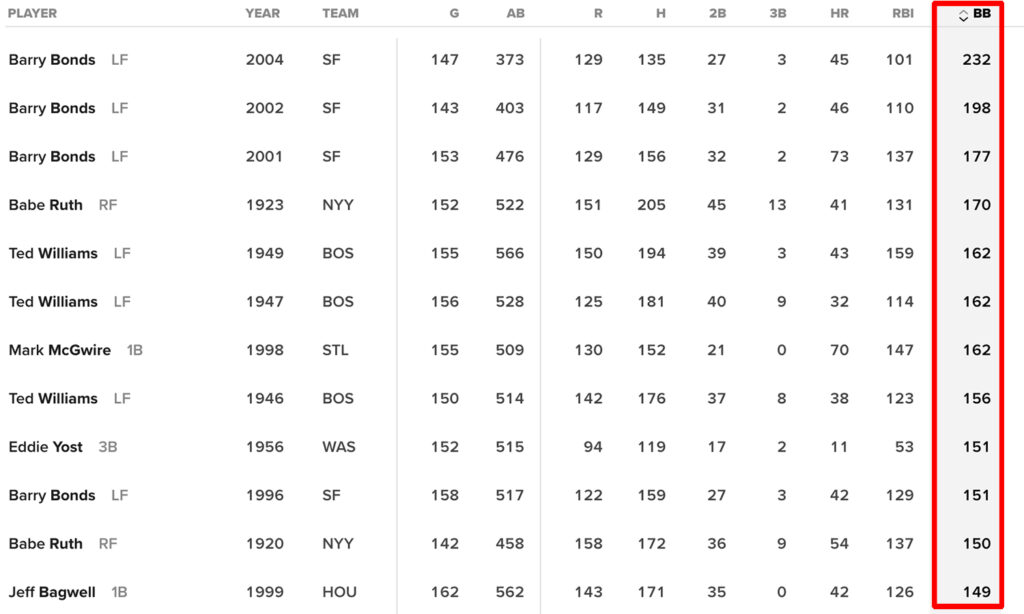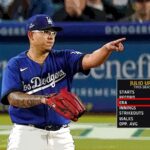If you’re watching a baseball game on TV or sifting through player profiles, you’ll be swarmed with stats.
Typically, everything is abbreviated as to fit nicely on the screen. But that will confuse those of us who are new to the game.
Look at the following image and then ask someone, who’s not familiar with baseball, to explain what is being displayed.

It’s like asking them to solve a complex math problem or handing over the instructions to assemble IKEA furniture.
You get the point, it’s a definite head scratcher.
One of the stats that can be attributed to both the pitcher and the hitter, is presented as BB.
A high BB total is a net negative for pitchers but considered rewarding to batters.
Before I tease you any further, let’s define BB.
What does BB mean in Baseball?
BB is an acronym for base on balls, which is commonly referred to as a walk. A walk means the batter is awarded first base either following four pitched balls or because the fielding team opted to, intentionally. Pitchers most commonly concede walks for strategic reasons, due to caution or in error.
When the pitcher gives up a base on balls, there is potential for the runner to get into scoring position.
For those that don’t know, the scoring position is when the baserunner makes their way onto second or third base.
So, starting from first base, the runner can end up on second base (or beyond) by different means.
They can steal a base, the pitcher or his teammates commit an error, the next batter safely hits the ball, elects to bunt, or hit a sacrifice fly.
There are so options once a runner gets on base. The batting team will do anything to drive that player home.
But giving up a walk is not the end of the world.
In fact, the fielding team may employ it for strategic purposes.
Intentional Walks (Base on Balls)
There are moments in a game where the coach chooses to intentionally walk the batter rather than have them square off against their pitcher.
As of 2017, MLB teams can signal to the umpire an intentional walk before the first pitch to that batter or on any count.
They can even go old school and throw low intensity pitches away from the plate.
At first thought, this would seem bizarre as you’re allowing a player to get on first base, free of charge.
But there is a method to the madness.
Potential Double Play
For example, let’s say there’s a runner already on second base and the batting team has only one out on the inning.
In this scenario, the pitcher can face the batter, who can potentially drive in an RBI with a runner on base.
If the batter successfully hits the ball to the outfield, not only will they score a run, but it’s likely they’ll continue the inning with one out.
Should he strike out or ground out, we’re still left with a player in scoring position.
However, if the pitcher walks the batter, now you have a player both on first and second base.
If the subsequent hitter is no slugger, then there is potential for a double play.
That is, if he were to hit a grounder, the opposition would have a great opportunity to end the inning in one fell swoop.
Depending on where the ground ball is hit, the fielding team tag out any combination of bases: 3-1, 2-1 or 3-2.
Mitigate Risk
Another reason to walk a player is to avoid a worse outcome. What do you do if runners are on second and third base and the next batter is a home run hitter?
Some teams elect to walk the batter and load the bases, rather than face power head on.
Again, loading the bases makes it easier to force multiple outs in one play.
But the subsequent batter may surprise you and score runs on their own.
Bases Loaded Walk
Imagine the same scenario as above, but with the bases loaded.
I’ve seen teams sacrifice the run instead of facing off with a slugger.
Usually, you’d see this when the fielding team is way ahead in the game.
The justification is that it is better to give up a run rather than risk four from a grand slam home run.
However, in the exact situation, the Arizona Diamondbacks elected to walk Barry Bonds with a two run lead. See the video snippet below.
Relationship between BB and OBP
While walk totals do not affect the player’s batting average, there is one stat that takes it into account.
That stat is known as OBP or on-base percentage.
The on-base percentage is defined as the number of times a batter reaches base over their total plate appearances.
This includes any hits, hit-by-pitch (HBP) and both intentional and unintentional walks.
I’d say, walks are earned, for the most part.
Aside from intentional walks, there is no pitcher that willingly gives up a base on balls.
They throw balls to make it harder for the batter to hit.
In some cases, what looks be a strike at first turns out to be a nasty curve ball way out of the strike zone.
Pitchers are magicians. It’s up to the batter to know what they’re up to and hold back.
Final Thoughts
As I expected, players awarded with the most walks are typically your home run hitters.
Don’t believe me? Take a look at the official MLB stats here.
The list is peppered repeatedly with players like Barry Bonds, Babe Ruth, Ted Williams and Mark McGwire.
However, one day someone must explain to me why Eddie Stanky was able to crack the top twenty for BB (148) in 1945.
Stanky only managed a single home run and had 0.258 batting average that year. His best season was 14 homers, with a career 0.268 AVG.
Perhaps this article clues us in.
While Stanky wasn’t imposing in size (measured 5’8, 170 lbs), he always stood very close to the plate and just never swung at balls.
Nonetheless, pitchers are never happy to give up walks.
If it was up to them, batters would whiff at every pitch, and they’d gladly take the strikeout each time.
In reality, batters will not go down without a fight.
It seems like no one wants to play ball.






